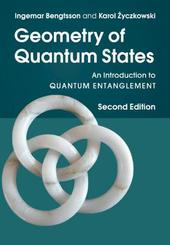
|
Geometry of Quantum States: An Introduction to Quantum Entanglement
Paperback / softback
Main Details
| Title |
Geometry of Quantum States: An Introduction to Quantum Entanglement
|
| Authors and Contributors |
By (author) Ingemar Bengtsson
|
|
By (author) Karol Zyczkowski
|
| Physical Properties |
| Format:Paperback / softback | | Pages:635 | | Dimensions(mm): Height 245,Width 170 |
|
| Category/Genre | Geometry
Physics
Quantum physics |
|---|
| ISBN/Barcode |
9781107656147
|
| Classifications | Dewey:530.12 |
|---|
| Audience | | Professional & Vocational | |
|---|
| Edition |
2nd Revised edition
|
| Illustrations |
22 Tables, black and white; 32 Halftones, black and white; 107 Line drawings, black and white
|
|
Publishing Details |
| Publisher |
Cambridge University Press
|
| Imprint |
Cambridge University Press
|
| Publication Date |
26 March 2020 |
| Publication Country |
United Kingdom
|
Description
Quantum information theory is a branch of science at the frontier of physics, mathematics, and information science, and offers a variety of solutions that are impossible using classical theory. This book provides a detailed introduction to the key concepts used in processing quantum information and reveals that quantum mechanics is a generalisation of classical probability theory. The second edition contains new sections and entirely new chapters: the hot topic of multipartite entanglement; in-depth discussion of the discrete structures in finite dimensional Hilbert space, including unitary operator bases, mutually unbiased bases, symmetric informationally complete generalized measurements, discrete Wigner function, and unitary designs; the Gleason and Kochen-Specker theorems; the proof of the Lieb conjecture; the measure concentration phenomenon; and the Hastings' non-additivity theorem. This richly-illustrated book will be useful to a broad audience of graduates and researchers interested in quantum information theory. Exercises follow each chapter, with hints and answers supplied.
Author Biography
Ingemar Bengtsson is a professor of physics at Stockholms Universitet. After gaining a Ph.D. in Theoretical Physics from the Goeteborgs universitet (1984), he held post-doctoral positions at CERN, Geneva, and the Imperial College of Science, Technology and Medicine, University of London. He returned to Goeteborg in 1988 as a research assistant at Chalmers tekniska hoegskola, before taking up a position as Lecturer in Physics at Stockholms Universitet in 1993. He was appointed Professor of Physics in 2000. Professor Bengtsson is a member of the Swedish Physical Society and a former board member of its Divisions for Particle Physics and for Gravitation. His research interests are related to geometry, in the forms of classical general relativity and quantum theory. Karol Zyczkowski is a professor at the Institute of Physics, Uniwersytet Jagiellonski, Krakow, Poland, and also at the Center for Theoretical Physics, Polska Akademia Nauk, Warsaw. He gained his Ph.D. and habilitation in theoretical physics at Uniwersytet Jagiellonski, and has followed this with a Humboldt Fellowship in Essen, a Fulbright Fellowship at the University of Maryland, College Park, and a visiting research position at the Perimeter Institute for Theoretical Physics, Ontario. He has been docent at the Academy of Sciences since 1999 and full professor at Uniwersytet Jagiellonski since 2004. Professor Zyczkowski is a member of the Polish Physical Society and Academia Europaea. He works on quantum information, dynamical systems and chaos, quantum and statistical physics, applied mathematics, and theory of voting.
Reviews'True story: A few years ago my daughter took a break from her usual question, 'Dad, what is your favourite colour?' and asked instead, 'What is your favourite shape?' I was floored! 'What a wonderful question; my favourite shape is Hilbert space!' 'What does it look like?' she asked. My answer: 'I don't know! But every day when I go to work, that's what I think about.' What I was speaking of, of course, is the geometry of quantum-state space. It is as much a mystery today as it was those years ago, and maybe more so as we learn to focus on its most key and mysterious features. This book, the worn first-edition of which I've had on my shelf for 11 years, is the indispensable companion for anyone's journey into that exotic terrain. Beyond all else, I am thrilled about the inclusion of two new chapters in the new edition, one of which I believe goes to the very heart of the meaning of quantum theory.' Christopher A. Fuchs, University of Massachusetts, Boston 'The quantum world is full of surprises as is the mathematical theory that describes it. Bengtsson and Zyczkowski prove to be expert guides to the deep mathematical structure that underpins quantum information science. Key concepts such as multipartite entanglement and quantum contextuality are discussed with extraordinary clarity. A particular feature of this new edition is the treatment of SIC generalised measurements and the curious bridge they make between quantum physics and number theory.' Gerard J. Milburn, University of Queensland Praise for the first edition: 'Geometry of Quantum States can be considered an indispensable item on a bookshelf of everyone interest in quantum information theory and its mathematical background.' Milosz Michalski, editor of Open Systems and Information Dynamics Praise for the first edition: 'Bengtsson's and Zyczkowski's book is an artful presentation of the geometry that lies behind quantum theory ... the authors collect, and artfully explain, many important results scattered throughout the literature on mathematical physics. The careful explication of statistical distinguishability metrics (Fubini-Study and Bures) is the best I have read.' Gerard Milburn, University of Queensland
|